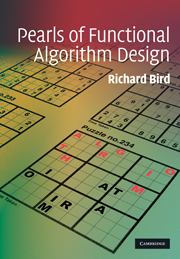Book contents
- Frontmatter
- Contents
- Preface
- 1 The smallest free number
- 2 A surpassing problem
- 3 Improving on saddleback search
- 4 A selection problem
- 5 Sorting pairwise sums
- 6 Making a century
- 7 Building a tree with minimum height
- 8 Unravelling greedy algorithms
- 9 Finding celebrities
- 10 Removing duplicates
- 11 Not the maximum segment sum
- 12 Ranking suffixes
- 13 The Burrows–Wheeler transform
- 14 The last tail
- 15 All the common prefixes
- 16 The Boyer–Moore algorithm
- 17 The Knuth–Morris–Pratt algorithm
- 18 Planning solves the Rush Hour problem
- 19 A simple Sudoku solver
- 20 The Countdown problem
- 21 Hylomorphisms and nexuses
- 22 Three ways of computing determinants
- 23 Inside the convex hull
- 24 Rational arithmetic coding
- 25 Integer arithmetic coding
- 26 The Schorr–Waite algorithm
- 27 Orderly insertion
- 28 Loopless functional algorithms
- 29 The Johnson–Trotter algorithm
- 30 Spider spinning for dummies
- Index
24 - Rational arithmetic coding
Published online by Cambridge University Press: 05 March 2013
- Frontmatter
- Contents
- Preface
- 1 The smallest free number
- 2 A surpassing problem
- 3 Improving on saddleback search
- 4 A selection problem
- 5 Sorting pairwise sums
- 6 Making a century
- 7 Building a tree with minimum height
- 8 Unravelling greedy algorithms
- 9 Finding celebrities
- 10 Removing duplicates
- 11 Not the maximum segment sum
- 12 Ranking suffixes
- 13 The Burrows–Wheeler transform
- 14 The last tail
- 15 All the common prefixes
- 16 The Boyer–Moore algorithm
- 17 The Knuth–Morris–Pratt algorithm
- 18 Planning solves the Rush Hour problem
- 19 A simple Sudoku solver
- 20 The Countdown problem
- 21 Hylomorphisms and nexuses
- 22 Three ways of computing determinants
- 23 Inside the convex hull
- 24 Rational arithmetic coding
- 25 Integer arithmetic coding
- 26 The Schorr–Waite algorithm
- 27 Orderly insertion
- 28 Loopless functional algorithms
- 29 The Johnson–Trotter algorithm
- 30 Spider spinning for dummies
- Index
Summary
Introduction
This pearl, and the one following, is all about arithmetic coding, a way of doing data compression. Unlike other methods, arithmetic coding does not represent each individual symbol of the text as an integral number of bits; instead, the text as a whole is encoded as a binary fraction in the unit interval. Although the idea can be traced back much earlier, it was not until the publication of an “accessible implementation” by Witten, Neal and Cleary in 1987 that arithmetic coding became a serious competitor in the world of data compression. Over the past two decades the method has been refined and its advantages and disadvantages over rival schemes have been elucidated. Arithmetic coding can be more effective at compression than rivals such as Huffman coding, or Shannon–Fano coding, and is well suited to take account of the statistical properties of the symbols in a text. On the other hand, coding and decoding times are longer than with other methods.
Arithmetic coding has a well-deserved reputation for being tricky to implement; nevertheless, our aim in these two pearls is to give a formal development of the basic algorithms. In the present pearl, coding and decoding are implemented in terms of arbitrary-precision rational arithmetic. This implementation is simple and elegant, though expensive in time and space. In the following pearl, coding and decoding are reimplemented in terms of finite-precision integers. This is where most of the subtleties of the problem reside.
- Type
- Chapter
- Information
- Pearls of Functional Algorithm Design , pp. 198 - 207Publisher: Cambridge University PressPrint publication year: 2010



